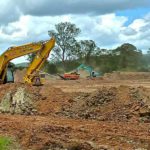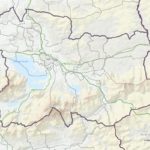The main source of radiation is of natural origin. The combined effect of all natural radioactivity contributes considerably more to the overall dose (87% of total) than do all of the artificial sources including medical diagnostics, nuclear power stations, and fall out from nuclear weapons testing. For this reason it is not surprising that natural radiation, particularly from Radon, has been attracting increasing attention.
Radon is a natural radioactive gas that has no taste, smell or colour and requires special equipment to detect its presence. It is found in all soils and rocks to some degree, but the amount can vary in different parts of the country and at different times of the year. Radon is formed in the ground by the radioactive decay of small amounts of radium which itself is a decay product of uranium. The gas rises to the surface and in the open air is quickly diluted to low and harmless concentrations in the atmosphere. However, once it percolates into an enclosed space, such as a building, it can accumulate to dangerous levels, depending on the concentration of radon in the underlying soil and the construction details of the building. Radon may also be introduced indoors by way of ground water supplied from a well, or from building material containing traces of radium. In Ireland the amounts from these sources are not normally of any consequence.
INDOOR RADON – POINTS OF ENTRY
The levels of radon in indoor air appear to have increased in recent decades, probably as a result of the desire for “tighter” building enclosures in order to reduce energy consumption. These levels depend mainly on the concentration of the sub-floor soil gas and the available entry points in the ground floor area of the building. As these factors usually vary from building to building each case must be considered separately. The more fragmented and porous the underlying rocks and soil the greater the amount of radon gas that can rise to the surface. This gas can enter a building in a convective flow through cracks and holes in the floor area and any gaps around service pipes and cables (Figure 1). it is usually pressure-driven owing to the slightly lower indoor air pressure compared with that under the floor, a result of wind and temperature difference.
As might be expected, elevated levels of radon resulting from soil gas are found mainly in basements and at ground floor level. Also, radon gas is nine times heavier than air, and therefore tends to remain close to the ground. Radon is not normally a problem in high rise buildings and if elevated levels are found it is likely to have been emitted from the materials used in construction.
Figure 1: Major Radon Entry Points
LUNG CANCER
The reason for concern about radon is its association with an increased risk of developing lung cancer. There is considerable evidence from studies of underground uranium miners and animal experiments to make this link with certainty. Radon being radioactive disintegrates and gives off decay products known as daughters or progeny which are also radioactive. These are minute particles which when released in the air may be inhaled and deposited in the lungs. As they in turn decay they give a radiation dose to the lung tissues which may eventually cause lung cancer.
This is not a matter that should cause immediate anxiety as it takes many years for the disease to develop and is normally considered as a lifetime risk. Not everyone exposed to elevated levels of radon is certain to develop lung cancer and while few people spend a lifetime in the same house it would be foolish to ignore the risk completely Radon induced cancer is not a problem to be concerned about in the short term, but the risk for some people over a lifetime is significant.
OCCURRENCE IN IRELAND
Radioactivity in air resulting from radon is measured in becquerel per cubic metre (Bq/m3). This unit of measurement means that radon is present at a concentration that emits one particle of radiation per second in a cubic metre of air.
A survey carried out by Dr. J.R McLaughlin of University College Dublin of a random sample of approximately 1300 houses in the State shows a median level of indoor radon of about 35 Bq/m3 throughout the country. However, levels in excess of 400 Bq/m3 were found in 1.5% of cases with individual peaks rising as high as 1700 Bq/m3. Most of these were located in counties Clare, Galway, Mayo and Cork, but even in these counties the vast majority of the sample houses had low radon levels.
A more recent survey of over 500 houses in some western counties was carried out by the Nuclear Energy Board and U.C.D. to identify the distribution of elevated concentrations in these areas. The results indicate that about 2.8% had radon levels above 400 Bq/m3 and that 9.4% were above 200 Bq/m3.
REFERENCE LEVEL
The only way of knowing if a house has a radon problem is to have a screening measurement carried out. A recommended Reference Level for Ireland has been set at 200 Bq/m’ for the annual average radon gas concentration in an existing home. Above this level action should be taken to reduce it. The level of 200 Bq/m3 is also intended to apply to all future houses which should be constructed so that radon concentrations are as low as reasonably practicable and certainly below this level. In existing houses, for levels up to 500 Bq/m3 it would be desirable to take action within a few years and where levels are over 1000 Bq/m3, within a year or so.
RISKS
For most people, the risk of developing lung cancer from radon is insignificant compared with other everyday risks. Nevertheless, despite the lack of complete agreement among experts on the precise risk, it has been calculated that exposure to the Reference Level of an annual average of 200 Bq/m3 corresponds to a lifetime risk of lung cancer of about 2.5%. The normal lifetime risk of contracting lung cancer in Ireland is about 3%.
International estimates now suggest that between 5% and 10% of lung cancer deaths may be caused by indoor radon exposure. There is also strong evidence which indicates a much higher risk from radon for cigarette smokers than for non-smokers. The National Radiological Protection Board in the U.K. puts this risk at 10 times that for non-smokers at all levels of exposure. This arises from a synergistic or multiplicative interaction of both carcinogens, which means that the combined effect exceeds the sum of the two effects taken independently.
METHODS OF DETECTION
The two most common devices used for measuring indoor radon concentrations are the alpha track detector and the charcoal canister. The charcoal canister is a small container of activated carbon which absorbs radon. It is exposed in a living area for about a week and then sent to a laboratory for analysis.
The alpha track detector gives a more accurate reading of the average exposure but must be left in place for a longer period, usually three months, to cover the widely fluctuating daily and seasonal variations. The detector consists of a small container which allows the alpha particles released by the radon to come in contact inside the container with a small piece of a special plastic in which tracks are formed by the radiation striking it. After exposure for the recommended time it is also sent to a laboratory for analysis. The initial screening measurement may indicate that there is no need for further action, but in some cases, it may be necessary to make measurements over a longer period to get a more accurate estimate of the average level.
There are other techniques requiring operation by trained personnel which can be used to give instant readings, but they are more expensive and, owing to the normal variation in concentrations over a short period of time, would be less reliable in determining the average radon level.
MEASUREMENT OF LEVELS
At present there is no reliable method for identifying the geographical areas most at risk. There is evidence linking high radon levels with underlying areas of uranium-bearing granite, shales, phosphate and certain sandstones, but this pattern is not entirely reliable. This makes it difficult to prepare maps predicting areas of high concentrations based on geological data. As an alternative, national surveys based on map grids are extremely expensive and lengthy exercises and produce only very general indications owing to the variations in radon concentrations that may occur within small areas.
In the absence of trustworthy maps or other methods of indicating places most at risk, it rests with individual householders to have their buildings tested if they are concerned. Measurements may be arranged by writing to either of the following:
Physics Department
University College Dublin
Belfield
Dublin 4.
A measurement will involve sending by post an alpha track detector with instructions on how it should be exposed in a house for some months before being returned for processing. The results will then be sent by post to the householder. There is a modest charge for this service.
The householder will be told either that no further action is necessary or, where a potential hazard has been indicated, that additional testing over a longer period would be advisable. If remedial measures are required, it may he necessary to seek professional advice from an architect or engineer who is competent to deal with this type of work, in order to decide on the appropriate action.
CORRECTIVE ACTIONS
Compared with existing houses, it is relatively easy when designing or building a new house to take precautions to deal with radon should the problem arise. The selection and design of a cost-efficient reduction system for an individual house will depend on a number of factors specific to that house.
Reduction techniques fall into two main categories: those aimed at preventing radon entering a house and those aimed at removing radon or its decay products after entry. Techniques which prevent radon entry include:
–> sealing soil gas routes into the house
–> sub-floor ventilation to draw or force soil gas away from the house before it can enter
–> adjustment of the air pressure inside the house to reduce or reverse the driving force which assists the entry of soil gas
Techniques which remove radon after entry include:
–> ventilation of the house
–> air cleaning devices to remove radon decay products
For persons who smoke cigarettes and are concerned about lung cancer attributed to radon, probably the most effective first action would he to give up smoking. For others, it may be prudent to begin by installing the simplest and least expensive method which offers reasonable potential for achieving the desired reduction. If this does not work, the system could then be expanded in a series of pre-designed steps until the level is reduced to that required.















